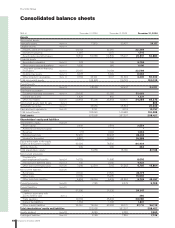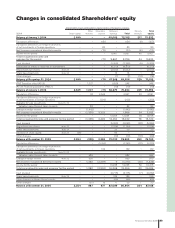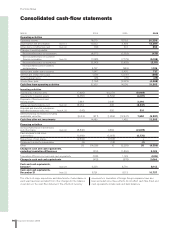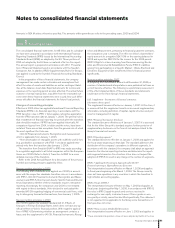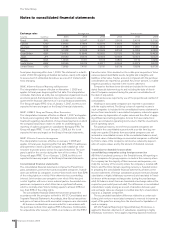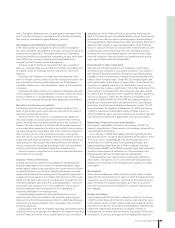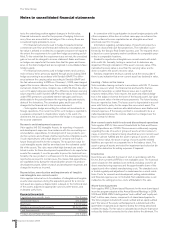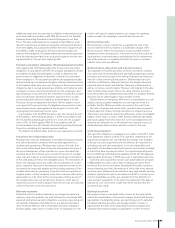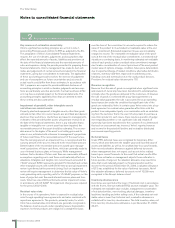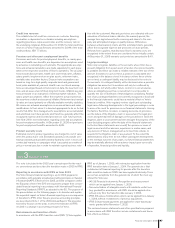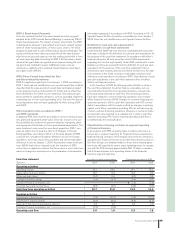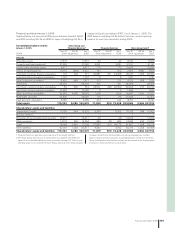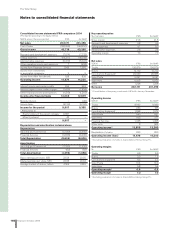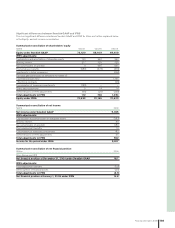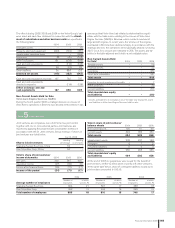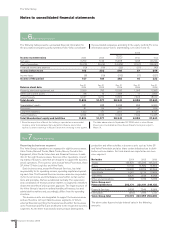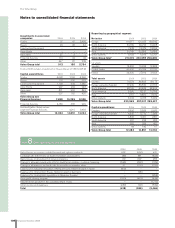Volvo 2006 Annual Report Download - page 102
Download and view the complete annual report
Please find page 102 of the 2006 Volvo annual report below. You can navigate through the pages in the report by either clicking on the pages listed below, or by using the keyword search tool below to find specific information within the annual report.
98 Financial information 2006
The Volvo Group
Notes to consolidated financial statements
Capitalization and amortization of development costs
Effective on January 1, 2001, Volvo adopted the accounting stand-
ard RR 15 “Intangible Assets” under Swedish GAAP. According to
this accounting standard, expenditures relating to development of
new and existing products and software should be capitalized and
amortized over their estimated useful life. According to the transition
rules for RR 15, no retroactive application was permitted. According
to the transition rules for IFRS, the accounting standard IAS 38,
Intangible Assets, which is mainly similar to RR 15 regarding the
accounting for development costs, should be applied retroactively for
development costs incurred prior to 2001. The restatements and
transition effects attributable to this accounting change therefore
pertains to retroactive capitalization and amortization of develop-
ment costs incurred prior to 2001.
Minority interests
In accordance with IFRS, minority interests are presented as a sep-
arate component of Shareholders’ equity and is included in the
income for the period in the income statement.
Non-amortization of intangible assets
with indefi nite useful lives
According to Swedish GAAP, all intangible assets have been amort-
ized over their estimated useful lives. In accordance with IFRS,
i ntangible assets considered to have indefi nite useful lives should
not be amortized. Such assets should rather be subject to an annual
impairment test. Volvo has determined that intangible assets with
indefi nite useful lives include only goodwill. Volvo has chosen not to
apply IFRS 3, retroactively in accodance with the IFRS transition
rules. The restatements and transition effects attributable to this
accounting change therefore pertain to reversal of goodwill amort-
ization charged to the income statement under Swedish GAAP for
2004 and a corresponding increase of the carrying value of goodwill
at December 31, 2004, adjusted for currency translation differences.
Employee benefi ts
Effective on January 1, 2003, Volvo adopted RR 29 “Employee bene-
fi t s ” under Swedish GAAP. RR 29 is similar to the IFRS accounting
standard IAS 19. The only difference between Swedish GAAP and
IFRS relates to the date of transition. In accordance with the transi-
tion rules of RR 29, actuarial gains and losses arising prior to Janu-
ary 1, 2003, were set to zero and charged to equity as of the transi-
tion date. In accordance with the IFRS transition rules, actuarial
gains and losses arising prior to January 1, 2004, could be set to
zero and charged to equity as of the transition date. The transition
effects attributable to the accounting change therefore pertain to
recognizing actuarial gains and losses that have arisen between
January 1, 2003 and January 1, 2004. Volvo has applied URA 43
according to the statement from the Swedish Financial Accounting
Standards Council in calculating the Swedish pension liabilities, in
addition to IAS 19.
Investments in other companies
Volvo accounts for all investments in companies, except if these
investments are classifi ed as associated companies in accordance
with IAS 39, Financial Instruments: Recognition and Measurement.
Companies listed on a fi nancial exchange should be reported in the
balance sheet to market value. Under Swedish GAAP such invest-
ments have been carried at their cost of acquisition unless there has
been a permanent decrease in value. Under IAS 39, unrealized gains
and losses attributable to the fair value of investments are reported
in a separate component of shareholders’ equity except when a
decline in value is other than temporary. The transition effect on
January 1, 2005, attributable to this accounting change is mainly
related to Volvo’s investment in Deutz AG.
Fair value of derivative instruments
In accordance with IAS 39, which is applied by Volvo as of January 1,
2005, all derivative fi nancial instruments should be reported in the
balance sheet at fair value. The difference between IAS 39 and
accounting principles applied for derivative fi nancial instruments
under Swedish GAAP is dependent on the use of the derivative
instruments:
– Derivative fi n ancial instruments used for hedging of forecasted
commercial cash-fl ows and forecasted electricity consumption:
Under Swedish GAAP Volvo has applied hedge accounting for the
main part of these derivatives and these instruments have conse-
quently not been reported in the balance sheet (“Off-balance sheet
instruments”). Gains and losses on these contracts have been
charged to the income statement at the time of maturity of the spe-
cifi c contracts. Under IFRS, the fair value of outstanding derivative
instruments is debited or credited to a separate component of equity
to the extent the requirements for cash-fl ow hedge accounting are
fulfi lled. To the extent that the requirements are not met, the unreal-
ized gain or loss is charged to the income statement.
– Derivative fi n ancial instruments used for hedging of interest-rate
risks and currency-rate risks on loans:
Under Swedish GAAP Volvo has applied hedge accounting for these
derivatives and the carrying value of such derivatives has therefore
corresponded to currency-rate and interest-rate gains and losses
accruable up to the reporting date. Under the more complex rules in
IAS 39 Volvo has chosen not to apply hedge accounting for interest
rate contracts. The difference between carrying values reported
under Swedish GAAP and fair values to be reported under IFRS per-
tains to unrealized interest rate gains and losses attributable to the
period between the reporting date and maturity dates of the deriva-
tives. The difference should be charged to income over the hedged
instrument’s remaining time to maturity. The unrealized gains and
losses will be charged to the fi nancial net in the income statement.
Derecognition of fi nancial assets
In accordance with IAS 39, which is applied by Volvo as of January 1,
2005, fi nancial assets should be derecognized from the balance
sheet when substantially all risks and rewards have been transferred
to an external party. Under Swedish GAAP, fi nancial assets should
be derecognized at settlement or if the ownership of the fi nancial
assets has been transferred to an external party. The transition
effect on January 1, 2005, attributable to this accounting change is
mainly related to certain dealer fi n ancing arrangements for which
Volvo has retained components of credit risk. Such credit risk com-
mitments have under Swedish GAAP been reported as contingent
liabilities. This has mainly affected the segment reporting and to a
less extent Volvo’s consolidated balance sheet.
Consolidation of temporary investments
Under Swedish GAAP, temporary investments in subsidiaries should
not be consolidated. Under IFRS, all subsidiaries should be consoli-
dated. Restatements and transition effects relating to this account-
ing change pertains mainly to Volvo’s investment in the LB Smith
distribution business. This operation was acquired in May 2003 and
at December 31, 2004, the major part of this operation had been
divested. The 2004 income statement is restated with the parts of
LB Smith that have been divested during the year. The remaining
part, still owned by Volvo, has been consolidated in full according to
Swedish GAAP in the fourth quarter of 2004.


